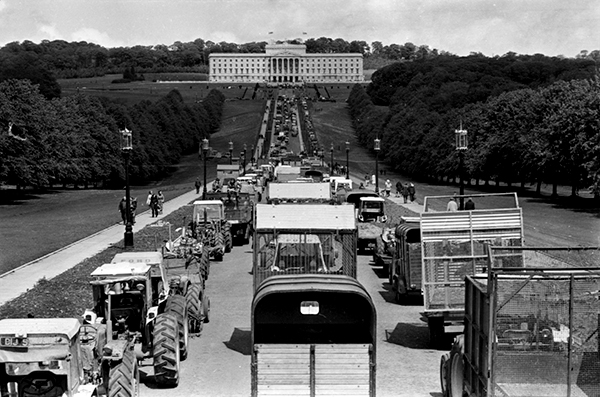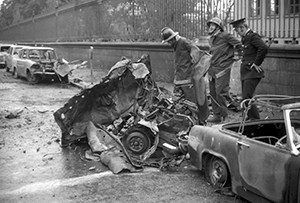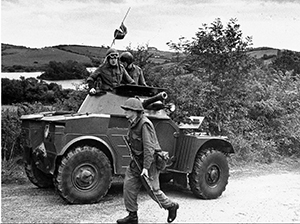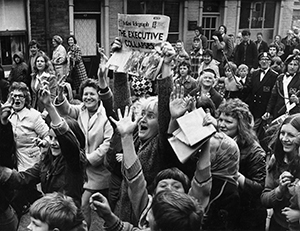‘The Bosnia that didn’t happen’?
Published in Features, Issue 5 (September/October 2020), Volume 28The 1974 Ulster Workers’ Council strike and fears of British withdrawal.
By Ian Wood
The high drama of August 1969, with communal violence breaking out in Northern Ireland and a troubled Taoiseach Jack Lynch telling RTÉ viewers that the State ‘can no longer stand by and see innocent people injured and perhaps worse’, has been fully analysed and documented. So, too, have the calls upon the Irish Defence Forces to prepare for possible cross-border operations if the northern situation worsened. In 2009 Tom Clonan revisited this fraught topic in a powerful documentary, which he scripted for RTÉ. Drawing on numerous interviews as well as State and army sources, he concluded that any deployment of Irish troops to Northern Ireland would have been a political and military disaster with the most far-reaching consequences.

Above: Farmers protesting outside Stormont in support of the UWC strike in May 1974. (Victor Patterson)
‘The need to consider the unmentionable’

Above: A brutal by-product of the UWC strike was the 17 May 1974 Dublin and Monaghan bombings. Pictured here is the wreckage of the third Dublin bomb at South Leinster Street. (Dublin City Library and Archive)
Cross-border operations by Irish forces did not, however, vanish completely from the political radar, even though, as Eunan O’Halpin has shown us, only limited success was achieved in increasing the strength of the Defence Forces in response to the Troubles. Less than five years after the crisis of August 1969, Northern Ireland plunged into even worse turmoil with the loyalist Ulster Workers’ Council (UWC) strike. A brutal by-product of this was the 17 May 1974 Dublin and Monaghan bombings, but it also forced a Labour government in London into full retreat from its declared policy of support for a power-sharing executive set up under the December 1973 Sunningdale Agreement.
Rumours travelled fast that Prime Minister Harold Wilson was losing his nerve over Northern Ireland and Britain’s commitment to keep its troops there. Bernard Donoughue, who was attached to the cabinet office in 1974, has recalled Wilson’s talking to him during the UWC strike of ‘the need to consider the unmentionable’, i.e. a British withdrawal of its forces from Northern Ireland. He had allies, like Home Secretary Roy Jenkins, whose famously fastidious tastes could not accommodate the idea of ‘the barbaric standards of Northern Ireland’ even needing to be part of the United Kingdom.
Some of this was simply the talk late at night of tired people with glasses in their hands. It was never, as Stuart Aveyard has stated, an argument that Wilson was going to win within the cabinet, whose secretary, Robert Armstrong, worked hard against any talk of withdrawal. Nevertheless, enough of what was being discussed leaked to Dublin to cause real alarm within the Cosgrave government. The evidence of this is there in abundance in the Irish State papers for 1974 and 1975, and also in the papers of Garret FitzGerald, who at one point confided his fears, while in Washington, to Secretary of State Henry Kissinger. The latter’s response was, predictably, somewhat guarded.
Some in Dublin felt that the loss of nerve over Northern Ireland by the Wilson government could prompt a loyalist paramilitary coup with dangerous implications for the minority community, given the ongoing level of sectarian murder by the UDA and the UVF. Their fears were heightened when the Irish army’s director of operations, Lt. Col. Kevin O’Brien, presented to ministers on the interdepartmental committee on Northern Ireland a document that was based on the likelihood of the victorious UWC strike being the prelude to a British troop withdrawal. The European Economic Community might, he suggested, call for a United Nations force to replace them, but until then the onus, in his view, would be on the Irish Defence Forces, who would have to take on loyalist paramilitaries across the border. For the State not to act would, he argued, ‘have a catastrophic effect on the Army. Morale would in all probability collapse. The consequences for the future of the Army and consequently the state as we know it would be most serious indeed.’
He saw October 1974 as the likely moment of crisis and believed that the army’s strength must be raised to 25,000 men. How this could be done within such a short period he chose not to explain, but he invoked Irish experience in UN operations in Cyprus and the Congo to argue that ‘civilians with army help can be protected’.
As to the Provisional and Official wings of the IRA, the latter of which had largely observed the ceasefire that it had called in May 1972, his view was that ‘the degree of support they would give to our forces is problematical’. Lt. Col. O’Brien thought that Irish troops deployed across the border might look for help from bodies like the Catholic Ex-Servicemen’s Association and the Central Citizens’ Defence Committee. The latter, from its base on the Falls Road, did communicate with the Dublin government in the form of a press release on 24 June 1974 that assumed a British withdrawal to be imminent. ‘History will probably judge’, this body declared, ‘that the Ulster Workers’ Council were more successful in putting the British out of Ireland in their fifteen-day rebellion than all the violence of the last four years.’ It remains unclear whether anyone in the Dublin government or civil service felt the need to reply to them.
Alarming reports from Down and Connor Catholic clergy

Above: An Irish army AML 60 Panhard car on border patrol in the 1970s, but larger troop-carrying vehicles were lacking. (NMI)
As worrying as any of this, and arguably more so for Dublin, were reports, starting in the early summer of 1974, from the Down and Connor Relief Advisory Service (DACARS), a Belfast body set up by priests within that diocese. They were fearful of what the summer might bring to the Catholic community if Britain withdrew and loyalist paramilitaries sought to seize power. They also felt that Cardinal Conway and their bishops were showing insufficient urgency about what might lie ahead. Led by Fr John O’Connor, they began to send Dublin alarming reports of what might happen. These included chilling inventories of Belfast’s sectarian geography, listing which areas could be ‘held’ and for how long against armed loyalists. These were said to include Unity Flats and the New Lodge Road, as well as Ardoyne, which were ‘almost 100 per cent Catholic with an extremely aggressive attitude … they have reasonable stores of food and there is a number of firearms in the district’. The security forces had learned this to their cost already.
Other nationalist areas such as the Short Strand and the Markets would have to be abandoned. The parish of Ligoniel in the north of the city was ‘in a hopeless situation’ should serious trouble break out, bounded as it was by hard-line loyalist estates. Its people would have to flee across Cave Hill and the Black Mountain to the safe haven of republican West Belfast. Population movement on this scale would need bedding, food and other essentials to be safely stored. In many reports passed on to Dublin, the DACRAS stressed the need to deny the IRA any role in their work and any chance to take credit for it. Civil servants in Dublin in contact with DACRAS and in actual meetings with Fr O’Connor were, mindful of events in August 1969, quick to talk of pogroms in the North. Others, perusing Fr O’Connor’s ‘orange and green’ maps of Belfast and other places, began to talk of ‘full-scale civil war’ and even a ‘holocaust’.
Patrick Donegan’s warning
Cross-border flight of Catholic families was another contingency regarding which DACRAS felt that it should alert Dublin. It planned to issue ‘execution vouchers’ to priests, which would give people cross-border clearance from the Gardaí and Irish Defence Forces. Here Fr O’Connor and two other priests, Frs Finnegan and Moran, were given a warning by Patrick Donegan, the Irish Minister for Defence, at a meeting in his office in Dublin in late August 1974. In 1969–70, he claimed, ‘people had used the vouchers for holiday purposes rather than out of real need’, and he stressed the limits to the Irish State’s capacity to help fleeing Catholics: ‘people in the North should be under no illusions about this’. He was echoing fears already voiced in cabinet discussions, where attempts had been made to cost the relief work that would be needed to help people fleeing across the border. The worst-case scenario had been of 100,000 people entering the republic, and not for ‘holiday purposes’. One civil service report advised the taoiseach that £6 million and perhaps more might be needed if a full-scale loyalist onslaught on the minority followed a British withdrawal.
Such a decision by London was always Dublin’s biggest fear and it reverberates in the State papers of this period, as Liam Cosgrave and his ministers agonised over how best to respond to an ever-worsening situation in Northern Ireland. Garret FitzGerald later wrote of the ‘terrible sense of impotence’ that he and his colleagues felt over the Wilson government’s losing the will to remain in Northern Ireland.
The impotence he spoke of was, of course, rooted in the inescapable reality that the Irish State had not the military capacity to intervene across the border. Cosgrave’s own interdepartmental committee on Northern Ireland was of the opinion that, even if the Defence Forces could be significantly strengthened, any cross-border operations by them might simply hasten a British withdrawal, as well as fuelling the worst fears of Ulster loyalists and so putting the minority community at even greater risk.
That same month Eamon Kennedy, the Irish ambassador in Washington, wrote to the Department of Foreign Affairs in Dublin that the best any Irish military action could achieve would be to clear the way for United Nations troops, who would simply be ‘lightly armed targets for the extremists of both sides’. Connor Cruise O’Brien, too, hammered home the futility of such action in forceful interventions, which can be read in Garret FitzGerald’s papers.
Views like these were always going to outweigh those of the ‘visitors from the North’ to whom Diarmaid Ferriter refers, especially SDLP delegations from Belfast. In August 1974 Dublin civil servants heard John Hume making the case for a joint Irish and British army operation, which ‘might be violent, but it would be mainly for the loyalists. Not much credibility is given to the loyalist paramilitary forces in a confrontation.’ A colleague of his, Aidan Larkin, followed on with a shaky analogy with events in Algeria, and he could ‘see many of the majority community leaving Ireland after a final settlement’.
Set against maverick contributions like these on how they should act, Irish ministers did the best they could with a very weak hand. Their reluctance to risk any sort of military intervention can only seem realistic and casts no reflection on the brave service the state’s Defence Forces have given, then and since, to the UN in some highly dangerous assignments.
‘In aid of the civil power’

Above: Loyalist women celebrate the collapse of the power-sharing executive on 28 May 1974. (Victor Patterson)
In April 1974, on the eve of the UWC strike, the Irish army, though it had undergone expansion since 1969, still numbered under 12,000 troops. Increasingly it was being deployed within the state ‘in aid of the civil power’, as the Gardaí were fully stretched by robberies and bank raids. These were being carried out by an IRA that, while adhering to its own standing order not to wage war on the state’s forces, had no inhibitions about ‘fund-raising’ or using the state as an operational base for cross-border attacks. At most, the army’s planners in 1974 calculated that 5,000 men might have been available for such operations. It also suffered from a top-heavy command structure with too many ageing officers, and was severely lacking in mobile artillery units and troop-carrying vehicles. The Air Corps was undermanned and devoid of the helicopters that would have been essential for troop deployments along the border. All this was a product of successive governments wanting neutrality on the cheap since the end of the Emergency in 1945.
Some officers, like Lt. Col. O’Brien, dared to introduce the word conscription to their assessments of the state’s military capability in 1974. They were only ever to get short shrift from the Cosgrave government in reply. Speaking in the Dáil in July of that year, Defence Minister Patrick Donegan, whose utterances had on occasions alarmed Garret FitzGerald, said that it ‘was not in our tradition. I have no plans to change that situation.’
Even an attempt to do so would have been a futile exercise, and so, too, was talk in 1974, just as it had been five years earlier, of deploying the Irish Defence Forces across the border. As Patrick Mulroe shows in his very fine study of the Irish border, the Cosgrave government was never going to be influenced by the case for cross-border action set out in the O’Brien document. He points out also that Cosgrave was in a stronger position than Jack Lynch had been in 1969, with no Neil Blaney-like figure pushing the case for intervention within the cabinet.
Had even a hint of any of these debates crossed the border and reached loyalist Ulster there is no telling what the results might have been. Garret FitzGerald knew what the risks were if his government gave out the wrong signals in 1974 and 1975. ‘Neither then nor since’, he wrote much later, ‘has public opinion in Ireland realised how close to disaster our whole Ireland came during the last two years of Harold Wilson’s premiership.’ He was right about this. Britain did not opt for withdrawal, but, had it done so, the consequences would have been incalculable.
Eamon Delaney also knew this when he edited Magill magazine’s special November 2006 issue devoted to these events. He wrote in it of what ethno-political hatreds had unleashed in the former Yugoslavia and called Northern Ireland ‘the Bosnia that didn’t happen but nearly did’. Near the end of her life, the late and fondly remembered Professor Elizabeth Meehan called the period in Northern Ireland since the Good Friday Agreement an exercise in ‘managed antagonism’. Her verdict was bleak but realistic and it described something much preferable to what could have happened if Britain had withdrawn from Northern Ireland and Dublin had made the wrong moves during the 1974 UWC strike and its aftermath.
Ian Wood is co-author (with Andrew Sanders) of Times of Troubles: Britain’s war in Northern Ireland (2012) and Crimes of loyalty: a history of the UDA (2006).
FURTHER READING
S.C. Aveyard, ‘We couldn’t do a Prague: British government responses to loyalist strikes in Northern Ireland, 1974–77’, Irish Historical Studies 39 (153) (May 2014).
D. Ferriter, Ambiguous Republic: Ireland in the 1970s (London, 2012).
P. Mulroe, Bombs, bullets and the border: policing Ireland’s frontier: Irish security policy 1969–1978 (Newbridge, 2017).
E. O’Halpin, Defending Ireland: the Irish state and its enemies since 1922 (Oxford, 1999).
















